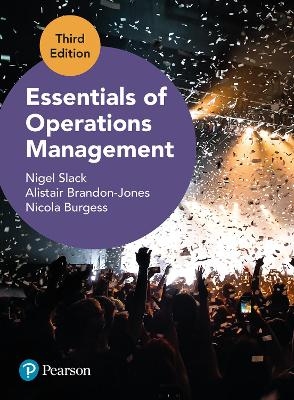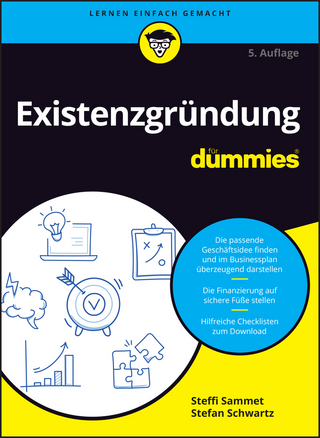
Essentials of Operations Management
Pearson Education Limited (Verlag)
978-1-292-44926-5 (ISBN)
Essentials of Operations Management, 3rd edition, by Nigel Slack, Alistair Brandon-Jones and Nicola Burgess is an essential resource for your teaching, with up-to-date examples, and a clear and highly practical approach.
Gain a comprehensive understanding of essential operations management principles with this easy to read introduction to the subject "This textbook provides valuable insight into the essentials of directing, designing, delivering and developing operations. For the times we live in, the addition of ‘responsible operations' at the end of each chapter makes the book an essential text for any operations management course."
Dr Philip Davies, Associate Professor of Operations Management
Henley Business School.
Operations may not run the world, but it makes the world run There has never been a more exciting time to study operations management. Fast and frequent changes to the way goods and services are produced and delivered, as well as an increased focus on the social responsibility of operations, present new opportunities and challenges for the business world. Operations management is critical to the success and survival of organisations everywhere, no matter how large or small.
Essentials of Operations Management, 3rd edition is a concise introduction to the subject and an invaluable resource, ideal for undergraduates in business studies, technical or joint degrees, as well as MBA and postgraduate students. Based on Slack, Brandon-Jones and Burgess's leading Operations Management, it focuses on essential core topics, without compromising the authoritative, clear and highly practical approach that has become the trademark of the authors.
Key features:
Revised and updated to reflect the ever-changing world of operations management.
Illustrations-based – rooted real-life practice with a wealth of examples showing ‘Operations in Practice' from a variety of businesses and organisations globally.
New ‘Responsible Operations' section in every chapter summarises how the topic touches upon social, ethical and environmental issues.
Problems and applications – practical exercises at the end of each chapter allow you to reflect on what you have learnt and test your understanding
Balanced and international approach – draws on a wide array of examples from organisations in different sectors and industries from around the globe.
Nigel Slack is Emeritus Professor of Operations Management and Strategy at Warwick Business School, an Honorary Professor at Bath University, and 'Honorary Fellow of the European Operations Management Association'. He is an educator, consultant, and writer with a wide experience in many sectors. Alistair Brandon-Jones is a Full Chaired Professor in Operations and Supply Chain Management, and Head of the Information, Decisions, and Operations Division at the University of Bath, School of Management. He is also an Adjunct Professor for Hult International Business School and Danish Technical University. Nicola Burgess is a Reader in Operations Management at W;arwick Business School. She has worked extensively with public sector organisations to understand operations management and improvement in a public sector context.
1 Operations management and performance Introduction
Key questions
1.1 What is operations management?
1.2 What is the input–transformation– output process?
1.3 Why is operations management important to an organisation's performance?
1.4 What is the process hierarchy?
1.5 How do operations (and processes) differ?
1.6 What do operations managers do?
Summary answers to key questions
Problems and applications
Want to know more?
Notes on chapter
2 Operations strategy Introduction
Key questions
2.1 What is strategy and what is operations strategy?
2.2 How does operations strategy align with business strategy (top-down)?
2.3 How does operations strategy align with market requirements (outside-in)?
2.4 How does operations strategy align with operational experience
(bottom-up)?
2.5 How does operations strategy align with operations resources (inside-out)?
2.6 How are the four perspectives of operations strategy reconciled?
2.7 How can the process of operations strategy be organised?
Summary answers to key questions
Problems and applications
Want to know more?
Notes on chapter
3 Product and service innovation Introduction
Key questions
3.1 What is product and service innovation?
3.2 What is the strategic role of product and service innovation?
3.3 What are the stages of product and service innovation?
3.4 What are the benefits of interactive product and service innovation?
Summary answers to key questions
Problems and applications
Want to know more?
Notes on chapter
4 Process design – resources Introduction
Key questions
4.1 Why is choosing the right resources important?
4.2 Do processes match volume–variety requirements?
4.3 Are process layouts appropriate?
4.5 Are job designs appropriate?
Summary answers to key questions
Problems and applications
Want to know more?
Notes on chapter
5 Process design – analysis Introduction
Key questions
5.1 Why is it important to get the details of process design correct?
5.2 What should be the objectives of process design?
5.3 How are processes currently designed?
5.4 Are process tasks and capacity configured appropriately?
5.5 Is process variability recognised?
Summary answers to key questions
Problems and applications
Want to know more?
Notes on chapter
6 Supply chain management Introduction
Key questions
6.1 What is supply chain management?
6.2 How should supply chains compete?
6.3 How should relationships in supply chains be managed?
6.4 How is the supply side managed?
6.5 How is the demand side managed?
6.6 What are the dynamics of supply chains
Summary answers to key questions
Problems and applications
Want to know more?
Notes on chapter
7 Capacity management Introduction
Key questions
7.1 What is capacity management?
7.2 How is demand measured?
7.3 How is capacity measured?
7.4 How is the demand side managed?
7.5 How is the supply side managed?
7.6 How can operations understand the consequences of their capacity management decisions?
Summary answers to key questions
Problems and applications
Want to know more?
Notes on chapter
8 Inventory management Introduction
Key questions
8.1 What is inventory?
8.2 Why do you need inventory?
8.3 How much should you order? (The volume decision)
8.4 When should you order? (The timing decision)
8.5 How can you control inventory?
Summary answers to key questions
Problems and applications
Want to know more?
Notes on chapter
9 Resource planning and control Introduction
Key questions
9.1 What is resource planning and control?
9.2 What is the difference between planning and control?
9.3 How do supply and demand affect planning and control?
9.4 What are the activities of planning and control?
9.5 What is enterprise resource planning (ERP)?
Summary answers to key questions
Problems and applications
Want to know more?
Notes on chapter
10 Operations improvement Introduction
Key questions
10.1 Why is improvement so important in operations management?
10.2 What are the key elements of operations improvement?
10.3 What are the broad approaches to improvement?
10.4 What techniques can be used for improvement?
10.5 Why is risk management also improvement?
Summary answers to key questions
Problems and applications
Want to take it further?
Notes on chapter
11 Lean operations Introduction
Key questions
11.1 What is lean?
11.2 How does lean consider flow?
11.3 How does lean consider (and reduce) waste?
11.4 How does lean consider improvement?
11.5 How does lean consider the role of people?
11.6 How does lean apply throughout the supply network?
Summary answers to key questions
Problems and applications
Want to take it further?
Notes on chapter
12 Quality management Introduction
Key questions
12.1 What is quality and why is it so important?
12.2 What steps lead towards conformance to specification?
12.3 What is total quality management (TQM)?
Summary answers to key questions
Problems and applications
Want to know more?
Notes on chapter
13 Project management Introduction
Key questions
13.1 What are projects?
13.2 What is project management?
13.3 How is the project environment understood?
13.4 How are projects defined?
13.5 How are projects planned?
13.6 How are projects controlled and learned from?
Summary answers to key questions
Problems and applications
Want to know more?
Notes on chapter
| Erscheinungsdatum | 02.03.2023 |
|---|---|
| Verlagsort | Harlow |
| Sprache | englisch |
| Maße | 200 x 267 mm |
| Gewicht | 990 g |
| Themenwelt | Sachbuch/Ratgeber ► Beruf / Finanzen / Recht / Wirtschaft ► Wirtschaft |
| Wirtschaft ► Betriebswirtschaft / Management ► Logistik / Produktion | |
| ISBN-10 | 1-292-44926-8 / 1292449268 |
| ISBN-13 | 978-1-292-44926-5 / 9781292449265 |
| Zustand | Neuware |
| Informationen gemäß Produktsicherheitsverordnung (GPSR) | |
| Haben Sie eine Frage zum Produkt? |
aus dem Bereich


